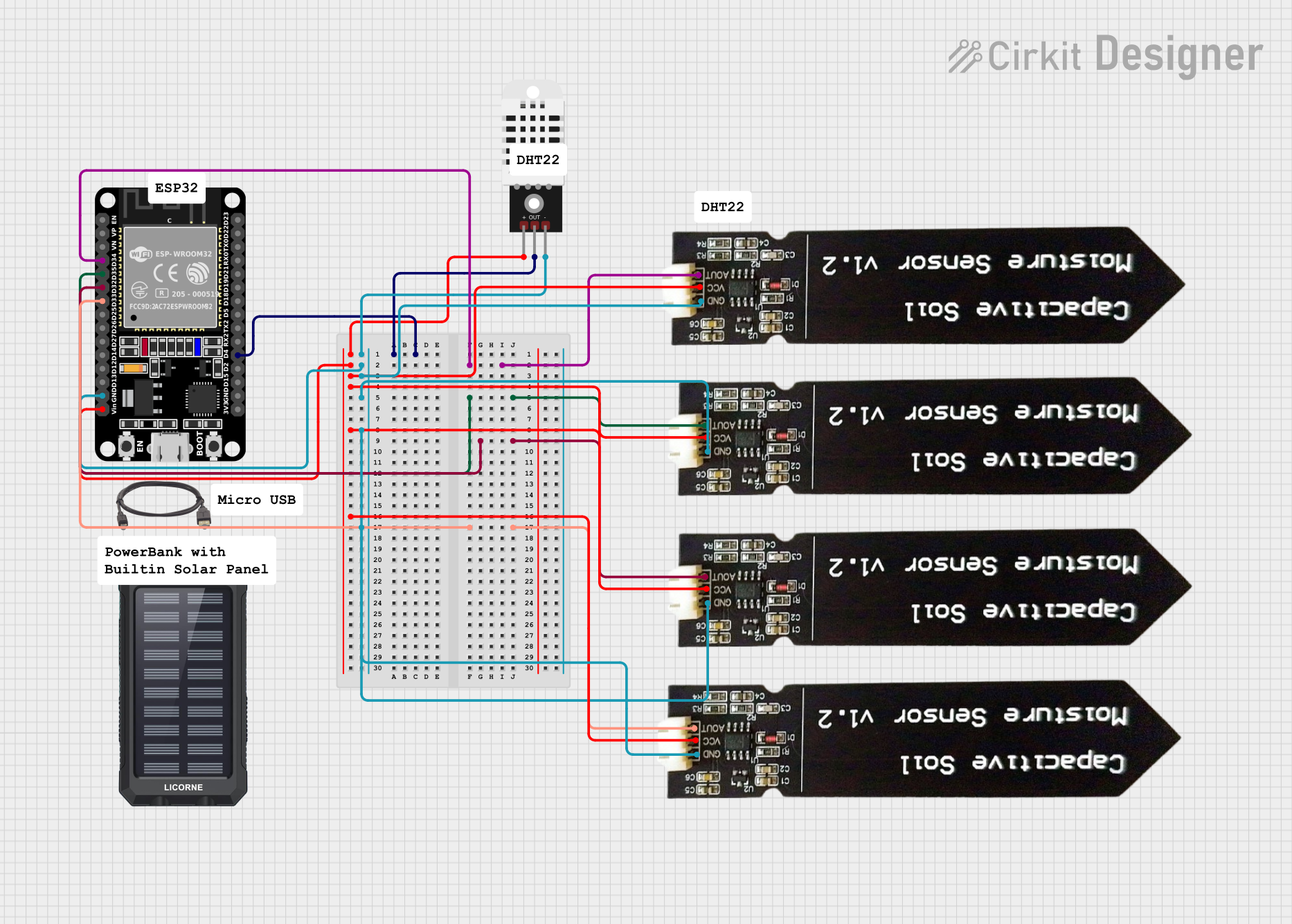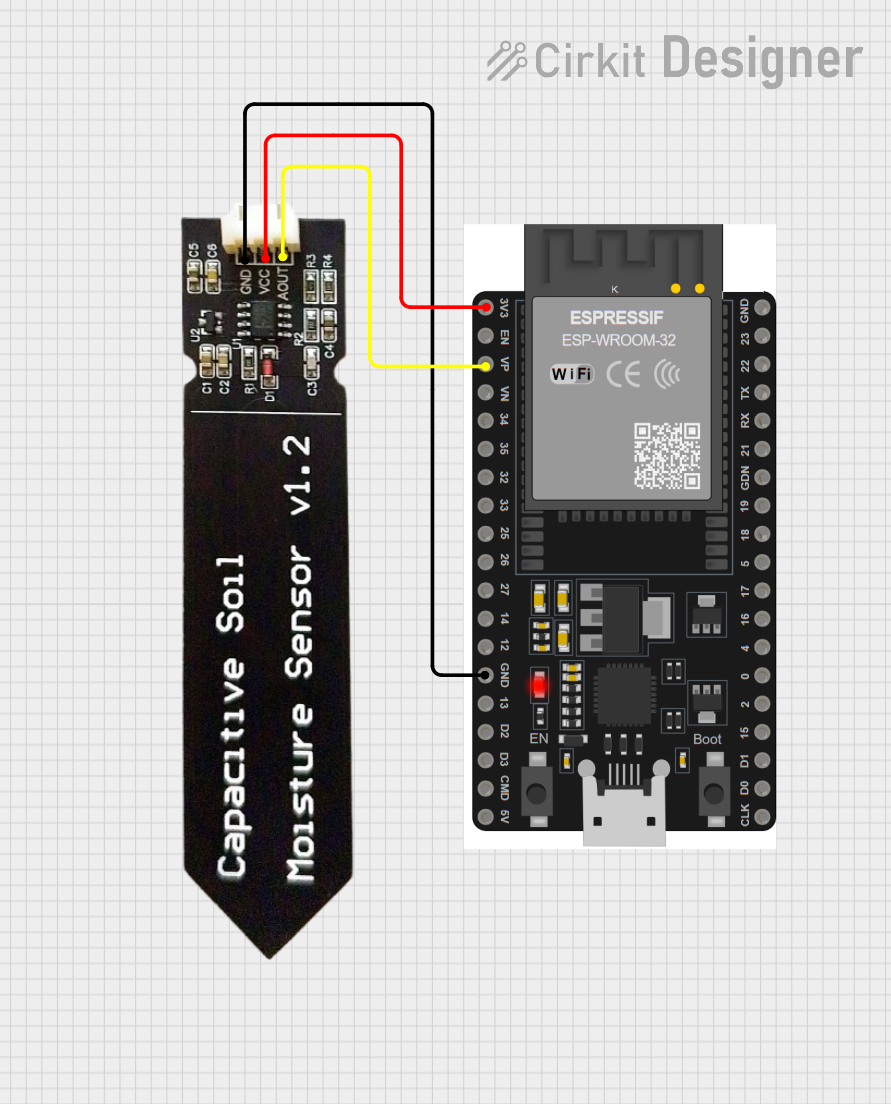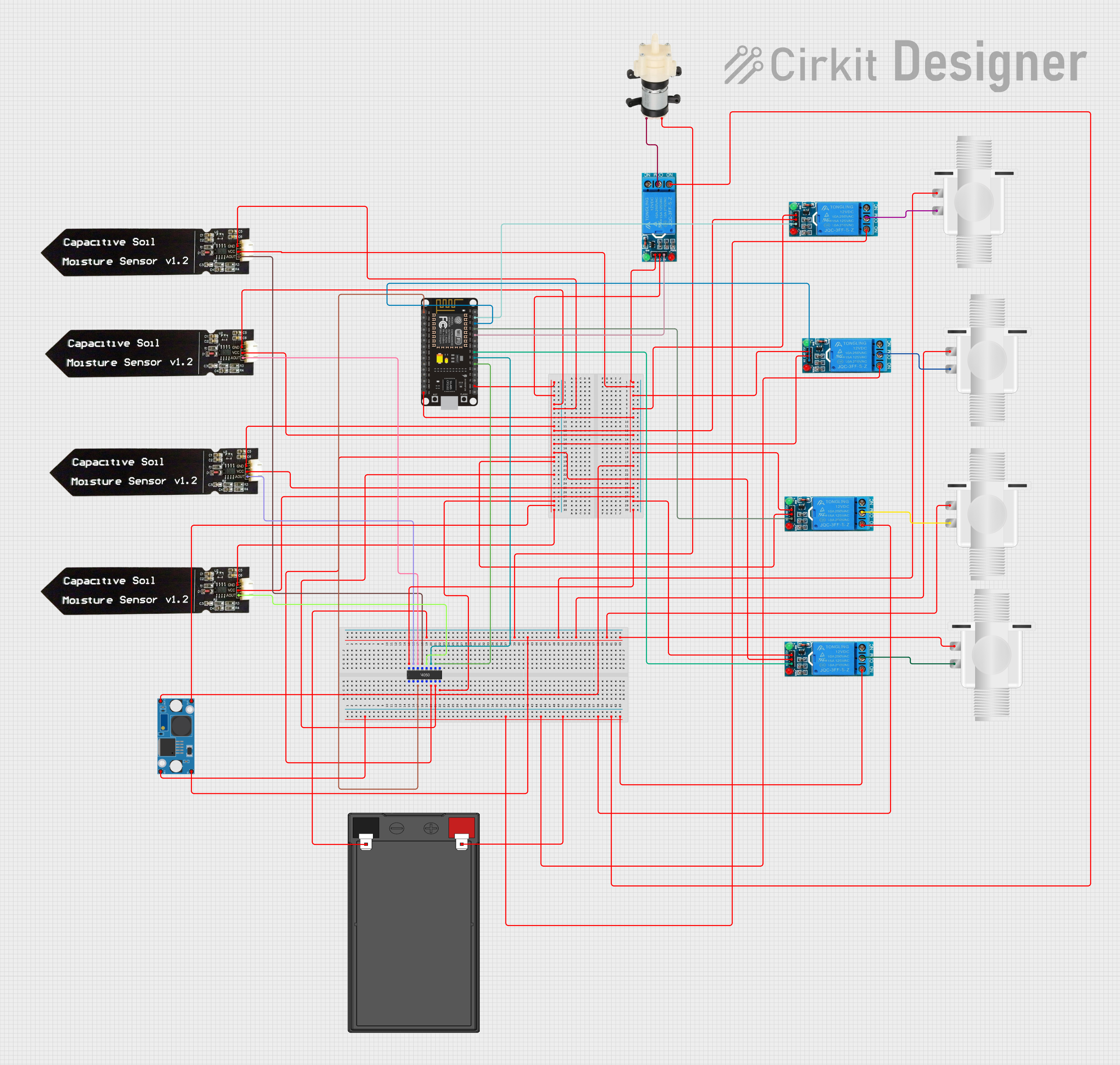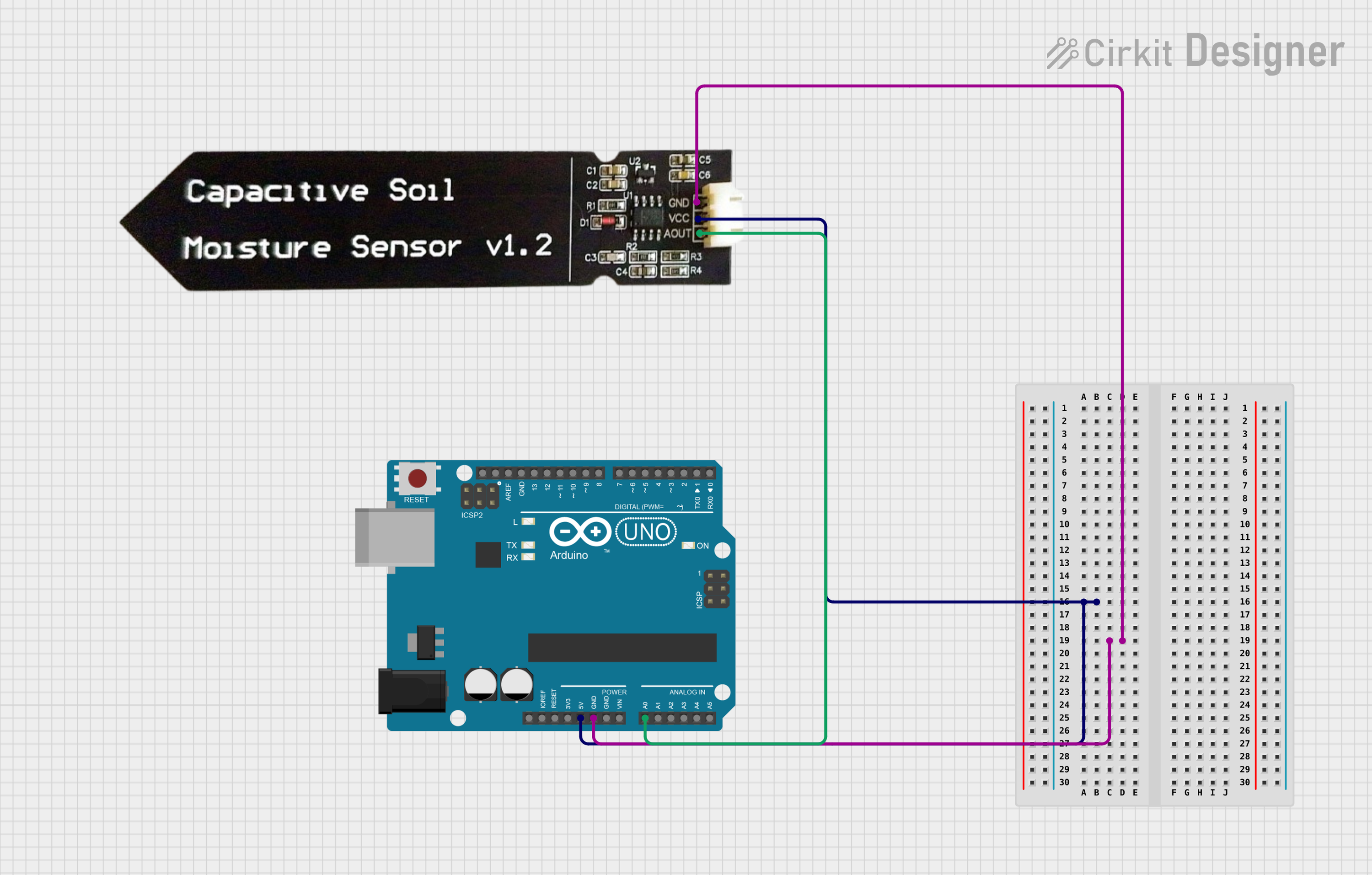
How to Use Capacitive Soil Moisture Sensor v2.0: Examples, Pinouts, and Specs

 Design with Capacitive Soil Moisture Sensor v2.0 in Cirkit Designer
Design with Capacitive Soil Moisture Sensor v2.0 in Cirkit DesignerIntroduction
The Capacitive Soil Moisture Sensor v2.0 by DFRobot is a reliable and durable sensor designed to measure the volumetric water content in soil. Unlike traditional resistive sensors, this sensor uses capacitive sensing technology, which eliminates the risk of corrosion and ensures long-term stability. It outputs an analog voltage corresponding to the soil moisture level, making it ideal for applications requiring precise and consistent moisture readings.
Explore Projects Built with Capacitive Soil Moisture Sensor v2.0

 Open Project in Cirkit Designer
Open Project in Cirkit Designer
 Open Project in Cirkit Designer
Open Project in Cirkit Designer
 Open Project in Cirkit Designer
Open Project in Cirkit Designer
 Open Project in Cirkit Designer
Open Project in Cirkit DesignerExplore Projects Built with Capacitive Soil Moisture Sensor v2.0

 Open Project in Cirkit Designer
Open Project in Cirkit Designer
 Open Project in Cirkit Designer
Open Project in Cirkit Designer
 Open Project in Cirkit Designer
Open Project in Cirkit Designer
 Open Project in Cirkit Designer
Open Project in Cirkit DesignerCommon Applications and Use Cases
- Agriculture: Automated irrigation systems for farms and greenhouses.
- Gardening: Monitoring soil moisture for home gardens and potted plants.
- Environmental Monitoring: Soil analysis in research and environmental studies.
- IoT Projects: Smart gardening systems integrated with microcontrollers like Arduino or Raspberry Pi.
Technical Specifications
Below are the key technical details of the Capacitive Soil Moisture Sensor v2.0:
| Parameter | Specification |
|---|---|
| Operating Voltage | 3.3V - 5.5V |
| Output Voltage Range | 0V - 3V (analog output) |
| Current Consumption | < 20mA |
| Interface Type | Analog |
| Dimensions | 98mm x 23mm |
| Weight | 15g |
| Operating Temperature | -40°C to 85°C |
| Material | Corrosion-resistant PCB |
Pin Configuration and Descriptions
The sensor has a 3-pin interface for easy connection to microcontrollers:
| Pin | Name | Description |
|---|---|---|
| 1 | VCC | Power supply pin. Connect to 3.3V or 5V depending on your microcontroller. |
| 2 | GND | Ground pin. Connect to the ground of your circuit. |
| 3 | AOUT | Analog output pin. Outputs a voltage proportional to the soil moisture level. |
Usage Instructions
How to Use the Sensor in a Circuit
Connect the Sensor:
- Connect the VCC pin to the 3.3V or 5V power supply of your microcontroller.
- Connect the GND pin to the ground of your circuit.
- Connect the AOUT pin to an analog input pin on your microcontroller (e.g., A0 on an Arduino UNO).
Insert the Sensor:
- Insert the sensor into the soil at the desired depth. Ensure the sensing area is fully covered by soil for accurate readings.
Read the Output:
- The sensor outputs an analog voltage that decreases as the soil moisture increases. Dry soil results in a higher voltage, while wet soil results in a lower voltage.
Important Considerations and Best Practices
- Calibration: The sensor's output voltage varies with soil type. Calibrate the sensor for your specific soil by measuring the output voltage in dry and saturated conditions.
- Placement: Avoid placing the sensor in rocky or compacted soil, as this may affect accuracy.
- Power Supply: Use a stable power source to ensure consistent readings.
- Protection: While the sensor is corrosion-resistant, avoid prolonged exposure to water or extreme conditions to extend its lifespan.
Example Code for Arduino UNO
Below is an example Arduino sketch to read and display the sensor's output:
// Capacitive Soil Moisture Sensor v2.0 Example Code
// This code reads the analog output of the sensor and displays the moisture level
// on the Serial Monitor.
const int sensorPin = A0; // Define the analog pin connected to the sensor
int sensorValue = 0; // Variable to store the sensor reading
void setup() {
Serial.begin(9600); // Initialize serial communication at 9600 baud
pinMode(sensorPin, INPUT); // Set the sensor pin as an input
}
void loop() {
sensorValue = analogRead(sensorPin); // Read the analog value from the sensor
Serial.print("Soil Moisture Level: ");
Serial.println(sensorValue); // Print the sensor value to the Serial Monitor
delay(1000); // Wait for 1 second before taking the next reading
}
Interpreting the Output
- The analog reading ranges from 0 to 1023 (on a 10-bit ADC like Arduino UNO).
- Higher values indicate dry soil, while lower values indicate wet soil.
- You can map these values to a percentage for easier interpretation.
Troubleshooting and FAQs
Common Issues and Solutions
No Output or Incorrect Readings:
- Cause: Loose or incorrect wiring.
- Solution: Double-check the connections. Ensure the VCC, GND, and AOUT pins are properly connected.
Fluctuating Readings:
- Cause: Unstable power supply or poor soil contact.
- Solution: Use a stable power source and ensure the sensor is firmly inserted into the soil.
Sensor Not Responding:
- Cause: Damaged sensor or incorrect voltage supply.
- Solution: Verify the operating voltage (3.3V - 5.5V). Replace the sensor if damaged.
Output Voltage Does Not Change:
- Cause: Soil type not suitable for the sensor.
- Solution: Test the sensor in different soil types and calibrate accordingly.
FAQs
Q1: Can this sensor be used outdoors?
A1: Yes, the sensor is designed for outdoor use, but it is recommended to protect the connections from water and extreme weather.
Q2: How do I calibrate the sensor?
A2: Measure the sensor's output voltage in completely dry soil and fully saturated soil. Use these values to map the readings to a percentage scale.
Q3: Can I use this sensor with a Raspberry Pi?
A3: Yes, but since the Raspberry Pi lacks an analog input, you will need an ADC (Analog-to-Digital Converter) module to read the sensor's output.
Q4: What is the lifespan of the sensor?
A4: The sensor is durable and corrosion-resistant, but its lifespan depends on usage conditions. Proper care and protection can extend its life significantly.